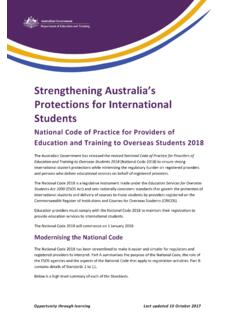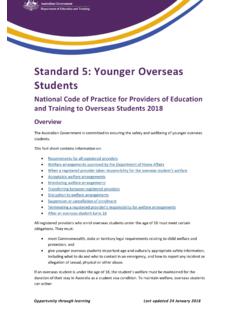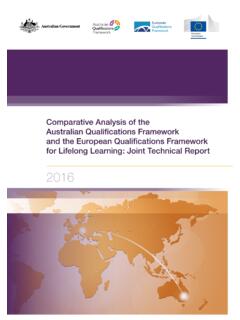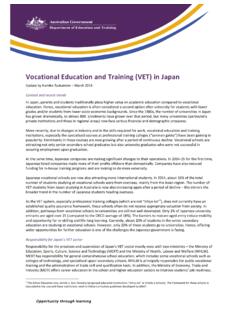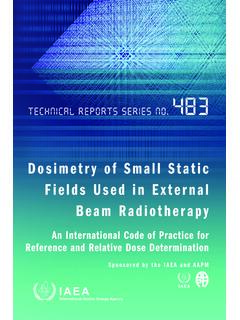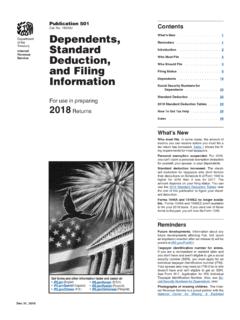Transcription of The value of international education to Australia
1 The value of international education to AustraliaPrepared by Deloitte Access EconomicsThe value of international education to AustraliaPrepared by Deloitte Access EconomicsAbout this reportIn 2015, the Australian Government Department of education and Training commissioned the Deloitte Access Economics to assess the value of international education to the Australian community. This assessment encompasses the sector s contribution to the Australian economy and its broader economic and social impact on regional communities, tourism and the calibre and productivity of Australia s workforce. For further information, please visit the website Deloitte Access EconomicsDeloitte Access Economics (ACN: 149 633 116) is Australia s pre-eminent economics advisory practice and a member of Deloitte s global economics group.
2 For more information, please visit the website Australian Government Department of education and Training would like to thank all those individuals and organisations that contributed to the study by supplying data and information and otherwise Commonwealth of Australia , its officers, employees or agents disclaim any responsibility for loss howsoever caused whether due to negligence or otherwise from the use of information in this publication. No representation expressed or implied is made by the Commonwealth of Australia or any of its officers, employees or agents as to the currency, accuracy or completeness of the information contained in this report. The reader should rely on their own inquiries to independently confirm the information and comment on which they intent to 978-1-76028-716-0 PDF 978-1-76028-685-9 DOCX 978-1-76028-690-3 Creative CommonsWith the exception of the Commonwealth Coat of Arms, the Department s logo, any material protected by a trade mark and where otherwise noted all material presented in this document is provided under a Creative Commons Attribution Australia ( ) details of the relevant licence conditions are available on the Creative Commons website (accessible using the links provided) as is the full legal code for the CC BY AU licence ( ).
3 The document must be attributed as the value of international education to value of international education to AustraliaContentsGlossary viExecutive Summary 11 Introduction 52 Quantifying the value of international education exports 8 How international education is captured by the ABS 8 ELICOS students on non-student visas 10 Offshore revenue 153 The economic contribution of international education 21 Contribution by mode of delivery 22 Contribution by sector 25 Industries best placed to leverage off future growth in international education 274 The regional contribution of international education 31 Contribution by state 31 Regional distribution of international students 35 Impact of international education on regional areas 375 Flow-on effects.
4 Visiting friends and relatives 41 Quantifying the links between international students and visiting friends and relatives 41 The economic contribution of visiting friends and relatives 436 The role of international education in developing a skilled workforce 46 The contribution of international students human capital to the Australian economy 47 The relative value of Australian international education 50 Building industry links and opening up new markets for Australian businesses 517 The broader benefits of international education to Australian communities 52 Broader economic and social benefits 52 Raising community awareness 56ivThe value of international education to AustraliaReferences 61 Appendix A: ABS treatment of international education services 65 Appendix B: Non-student visa ELICOS student revenue 67 Appendix C: Economic contribution modelling framework 70 Appendix D: Student contribution estimation methodology 73 Appendix E: Regional contribution 77 Case study 1: Armidale 77 Case study 2: Impact of international economic activity on regional Victoria 80 Appendix F: VFR contribution estimation 81 Limitation of our work 84 ChartsChart : international student enrolments over time 6 Chart : Trends in student enrolments by nationality 7 Chart : ELICOS enrolments by visa type, 2014 12 Chart : ELICOS average course study length by visa type, 2014 13 Chart : ELICOS export revenue by source, 2014 15 14 Chart.
5 Offshore higher education student numbers, 2012 14 16 Chart : Offshore VET student enrolments, 2011 2013 17 Chart : Total value added by education sector, 2014 15 26 Chart : Indirect value added to GDP from international education fees, 2014 15 27 Chart : Direct value added to GDP from living expenses, 2014 15 28 Chart : Indirect value added to GDP from living expenses, 2014 15 29 Chart : relative total international education contribution to states, 2014 15 32 Chart : Indirect value added from tourism activity, 2014 15 44 Chart : international student enrolments by broad level of course, 2014 79vThe value of international education to AustraliaTablesTable 1: Contribution of international education to employment, 2014 15 2 Table Export value of international education captured by ABS, 2014 15 9 Table : Export value of NSV ELICOS enrolments, 2014 15 14 Table : Students at overseas delivery locations by provider type, 2014 18 Table : Contribution summary of international education services, 2014 15 23 Table : Illustration of how $1 of revenue translates to value added for onshore and offshore university operations 25 Table : Contribution summary by sector, 2014 15 26 Table : international education export revenue by category and state, 2014 15 32 Table : Contribution of international education by state, 2014 15 34 Table : international Higher education contribution to LGA, 2014 15 38 Table.
6 Contribution of Melbourne international student spending, 2014 15 40 Table : Contribution of friends and relatives visiting international students, 2014 15 43 Table : Contribution of friends and relatives visiting students by state, 2014 15 45 Table : IO categorisation by education provider mode and sector 74 Table : Contribution multipliers for international students, 2014 15 76 Table : Share of employment by industry, 2011 77 FiguresFigure : Different modes of international education delivery 10 Figure : Top four source countries for offshore programs 16 Figure : Biggest campuses by capital and non-capital SA4 regions, 2015 36 Figure : international student contribution by region, 2014 15 39 Figure : Visitors coming to Australia to visit an international student relative to those who visit an international student while they are in Australia 43 Figure : Broader economic and social benefits of international education 53 Figure : Process diagram for estimating export revenue for NSV ELICOS students 69 Figure : Economic activity accounting framework 71 Figure : Distribution of visitors visiting an international student, 2014 81 Figure.
7 Adjustment process for the Input-Output modelling 82viThe value of international education to AustraliaGlossaryABSA ustralian Bureau of StatisticsACPETA ustralian Council for Private education and TrainingANZSICA ustralian and New Zealand Standard Industrial ClassificationARCA ustralian Retail CollegeAIHSTA ustralian Institute of Health Science and TechnologyCRICOSC ommonwealth Register of Institutions and Courses for Overseas StudentsDETC ommonwealth Department of education and TrainingDIBPD epartment of Immigration and Border ProtectionEDtECHE ducation TechnologyELICOSE nglish Language Intensive Courses for Overseas StudentsFTEFull-Time EquivalentGOSG ross Operating SurplusGVAG ross value AddedHSCH igher School CertificateIOInput-OutputLGAL ocal Government AreaMCEETYAM inisterial Council on education , Employment, Training and Youth AffairsNCVERN ational Centre for Vocational education ResearchNSVNon-Student VisaPC Productivity CommissionTRAT ourism Research AustraliaTVAT otal Vocational education and Training ActivityUNEU niversity of New EnglandVCEV ictorian Certificate of EducationVETV ocational education and TrainingWHMW orking Holiday Maker1 The value of international education to AustraliaExecutive SummaryThis report has been commissioned by the Australian Government Department of education and Training to assess the value of international education to the Australian community.
8 This assessment encompasses the sector s contribution to the Australian economy and its broader economic and social impact on regional communities, tourism and the calibre and productivity of Australia s workforce. The analysis encompasses international students studying at schools, vocational education and training (VET) providers, higher education providers and those studying English Language Intensive Courses for Overseas Students (ELICOS) value of international education exports In 2014 15, the ABS valued exports from international education at $ billion, making it Australia s third largest export. The analysis presented in this report builds on this figure by examining and where possible quantifying avenues of export revenue not captured in the ABS statistics. These include: education related expenditure by those on non-student visas studying ELICOS, which is estimated to contribute an additional $205 million in export revenue; tourism expenditure by visiting friends and relatives who come to Australia to visit an international student, which is estimated to be worth $282 million; revenue from offshore campuses which is estimated to be worth $434 million in 2014, comprising $382 million from higher education and $53 million from VET; and revenue from international students undertaking study tours at Australian public schools, which was estimated to be worth $14 million in 2015.
9 Collectively, these figures indicate that international education contributes an additional $935 million in export revenue to Australia , taking the sector s overall export revenue to an estimated $ billion in 2014 15. This should be seen as a conservative estimate of the additional export revenue from these sectors. Relatively little information is available on the offshore revenue earned by private contribution of international education to the Australian economy This export revenue was estimated to support over 130,700 Full Time Equivalent (FTE) employees in 2014 15, accounting for of Australia s total employment. The contribution of international education to employment at a state and territory level is shown in Table i below, with international education supporting between (Victoria) and (NT) of all employment at a state and territory level.
10 2 The value of international education to AustraliaTable 1: Contribution of international education to employment, 2014 15 State or TerritoryFull Time Equivalent (FTE) jobsProportion of employmentNew South Wales46, , , Australia8, Australia9, , Capital Territory2, , : Deloitte Access : These figures include the contribution associated with visiting friends and relatives. While export revenue is a useful measure of the gross value of activity associated with international education , contribution to GDP is the most accurate measure of the net effects of international education on the Australian economy and on the living standards of Australians. After accounting for the fact that some of inputs to the goods and services consumed by international students and their visitors are imported, international education was estimated to contribute $ billion to Australia s GDP in 2014 15.

